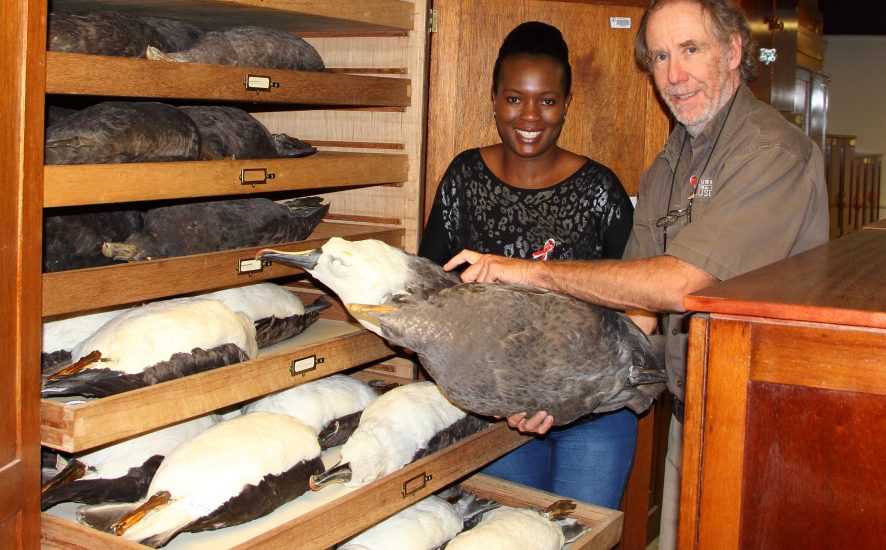Durban Museum staffers Mmatjie Mashao with a skin of an Indian Yellow-nosed Albatross Thalassarche carteri and David Allan holding a giant petrel Macronectes sp., next to the cabinet holding more specimens, fittingly photographed on Antarctica Day (coincidentally also World AIDS Day, hence their lapel ribbons)
The on-line SPRI Polar Directory hosted by the University of Cambridge’s Scott Polar Research Institute provides “brief details of libraries, museums and organisations with interests relating to the polar and cold regions; that is, to the Arctic and Antarctic and to all parts of the world where ice, snow and permafrost are to be found.”
Noting the current woeful coverage of only 13 registered institutions in the country – nearly all with seriously out-of-date details – the Antarctic Legacy of South Africa has taken on the challenge of encouraging South African institutions with polar connections to register with the international directory. Bayworld, of which the Port Elizabeth Museum forms part, was the first to respond, registering its valuable collection of Southern Ocean seal and whale osteological material (click here).
The Durban Natural Science Museum (DNSM) has now followed, registering its Bird Department’s equally valuable Polar Collection of prepared bird study skins, birds preserved in ethanol, bird skeletons, freeze-dried birds and eggs.
The museum’s Polar Collection is dominated by study skins and eggs, with only an additional two freeze-dried specimens. Most of the collections were made in 1970s and 1980s, with only a few specimens collected as early as the 1950s. The polar collections are mainly from the Southern Ocean islands of Marion, Gough, Tristan da Cunha, Inaccessible and Nightingale. What makes the DNSM’s Polar collection additionally interesting is a collection of non-seabirds, such as a vagrant Common Nighthawk Chordeiles minor from Tristan da Cunha prepared as a skeleton in 1988. The collection includes penguins, albatrosses, petrels, shearwaters, sheathbills, skuas, gulls, terns, noddies, rails, moorhens and finches. The total number of bird specimens in the museum’s Polar Collection is 498.
With thanks to David Allan, Curator of Birds and Mmatjie Mashao, Technical Assistant: Birds, Durban Natural Science Museum
John Cooper, Principal Investigator, Antarctic Legacy of South Africa, Department of Botany and Zoology, Stellenbosch University, 03 December 2016

